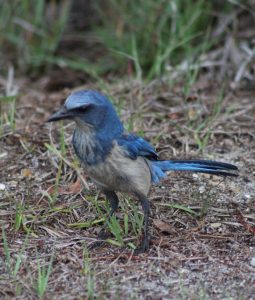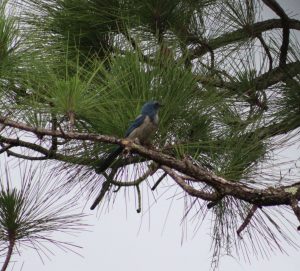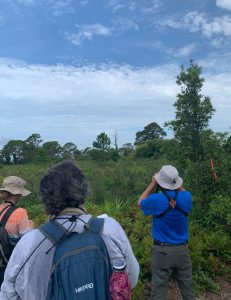As a Florida native, I’ve become fascinated by our sole endemic bird: the Florida scrub jay. When offered the opportunity to help survey populations in the Sarasota area, I couldn’t resist, and by just 10:30am I had seen my first jays, helped serve the public, and had certain revelations.
Florida Scrub Jays

Identification
Florida Scrub Jays are a small, blue and grey birds lacking the black markings and crest of a blue jay. When identifying scrub jays, you don’t always get the best look, so it can be helpful to recognize them by their silhouette: long body with a long tail angled downward, and a pretty prominent beak.
They also have distinct vocalizations to aid in identification as the are often hard to spy within the scrub they call home.
Florida Scrub Jay calls [generic and hiccing (a unique vocalization performed by females)]

Family Groups
Unlike most birds, Florida Scrub Jays actually live in family groups and are cooperative breeders. A family is comprised of 2 adults and up to 6 helpers assigned the tasks of look-out and forager. Juveniles become independent at 3 months, but may stick around as part of the family until they decide to move on and establish a territory of their own.
Caching
While young and adolescent jays need high protein diets and are sustained by insects and arthropods, come winter, Florida Scrub Jays have a unique method of guaranteeing plentiful food for the harsher seasons. Packing them into fine quartz sand patches of the scrub, jays can stock (or cache) over 8,000 acorns each season. These reserves help them to make it through the winter, and jays make super stockpilers paying special attention to acorn tannin content (a natural preservative) and having an 80% retrieval rate –impressive by any standards!
Umbrella Species
Florida Scrub Jays act as habitat indicators. When the scrub gets overgrown, jay numbers tend to decline indicating the need for a prescribed fire, or mechanical management, to restore habitat. Once the scrub has been restored to a 4-6 foot optimal height, populations tend to rebound.
Sometimes known as an “umbrella species”, scrub jays also serve as indicators for the population status of other important species that are harder to survey. Florida Scrub Jay populations can be used to estimate numbers of other scrub specialists like the gopher tortoise, Eastern indigo snake, Florida scrub lizard, sand skink, and a variety of vegetation.
Jay Watch
Established in 2002 by Archbold Biological Station, the Jay Watch Program is now Florida Audubon’s initiative to monitor the Florida Scrub Jay. Utilizing the power of civilians, they’re able to draft annual reports on populations at sites across the state.
Who? When? How? Why?

The who of this is twofold: the humans and the jays. Anyone (read any person) can get involved. From the youngest volunteer being just 17 and the eldest coming in at 92, the only real requirements for surveying are interest and a decent tolerance for heat. New surveyors are paired with more experienced ones so experience and even birding background isn’t necessary.
So when does this happen? Jay Watch runs from June 15 – July 15 and begins promptly each morning. Areas are surveyed for three consecutive days in attempts of producing consistent data. The window for surveying is limited to this period as juveniles have left their nest and will move with the family but can still be distinguished from mature adults by their brown/grey coloring, lack of back marking, thin neck, and the overall disgruntled look of new feathers.
How does this go down? The protocol is pretty specific (see resources below) but, to over-simplify, after scouring for possible predators, biologists and trained Jay Watch volunteers record sightings of jays and collect data. Adult and juveniles are recorded in separate columns along with information about time, weather, and other species. Then on to the next stop!
The most important piece to this process is why? Why wake up at 6am? Why organize across the state? Why the effort?
Well, surveying efforts are essential for monitoring populations and thus making decisions about land management. Having accurate counts of populations and an understanding of whether families are reproducing or declining indicates when a burn may be appropriate or when habitat has become insufficient due to the encroachment of surrounding development. Moreover, as an umbrella species, knowing how Florida Scrub Jays are fairing indicates how other crucial species may be thriving or struggling. From a point of information we’re able to advocate and act with authority.
My Experience
My morning began even before my alarm as a mixture of excitement and anxiety for being late had woken me. Upon arriving at our surveying destination, we made our way to the first site and cast the first call out into the landscape. Cottontails, cardinals, and red-bellied woodpeckers abound, but no signs of our favorite feathered friends. We moved through a few more sites, knowing there were likely two families in the area.

As the day became hotter, the scrub seemed to get higher, and the surrounding houses closer. We were fortunate enough to have encountered at least two Florida scrub jays, but the prospects look bleak for the population as a whole.
There is the reassuring thought that maybe they’ve just begun to understand the calls to be anthropogenic, and not worth inspection, but life is tough for Florida scrub jays. Not only were we unable to spot more than a single family, I learned much about their diminishing habitat and all the efforts that go into preserving scrubby habitat. Fires must be prescribed (an arduous task) to keep the scrub at a certain height as we often suppress naturally occurring fires that once provided this service. Moreover, development has gobbled up much of the habitat needed to sustain scrub jays, and the plots we have left are often disconnected from one another leaving the jays genetically isolated and susceptible to inbreeding.
So I have a new question to ask: what will it take? People are sacrificing their time and energy to monitor populations and facilitate prescribed fires. But it doesn’t always seem to be enough. What now?
How to Get Involved
While July 15th, marks the end of this year’s Florida Jay Watch, continuing to educate yourself remains essential, so you’re better prepared for the seasons to come.
Audubon Florida’s Jay Watch Page
Jay Watch Survey Protocol Webinar (Audubon Florida)
Learn More About Florida Scrub Jays
Wild Sarasota: Florida Scrub Jays Webinar (UF/IFAS Extension Sarasota County)
Florida Scrub Jay Ecology Webinar (Audubon Florida)
 0
0
